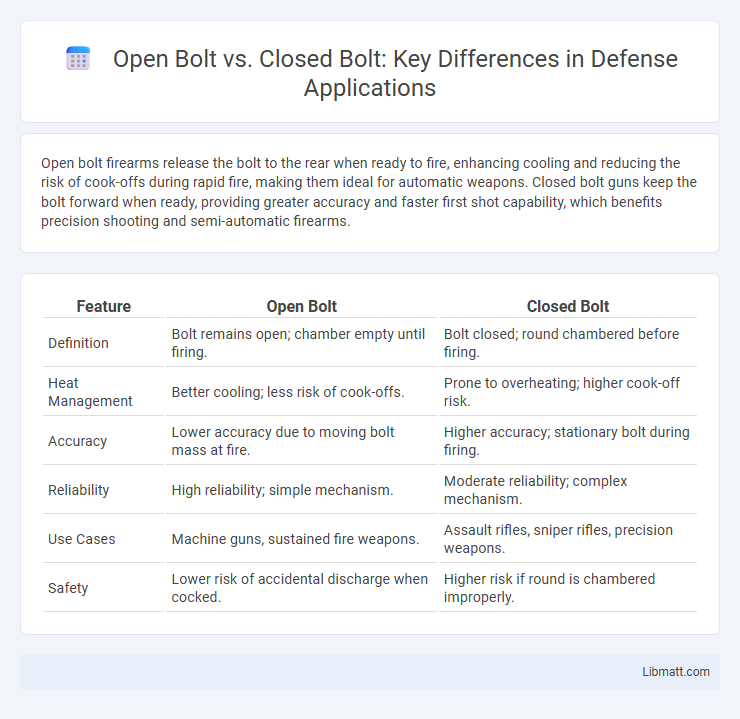Open bolt firearms release the bolt to the rear when ready to fire, enhancing cooling and reducing the risk of cook-offs during rapid fire, making them ideal for automatic weapons. Closed bolt guns keep the bolt forward when ready, providing greater accuracy and faster first shot capability, which benefits precision shooting and semi-automatic firearms.
Table of Comparison
| Feature | Open Bolt | Closed Bolt |
|---|---|---|
| Definition | Bolt remains open; chamber empty until firing. | Bolt closed; round chambered before firing. |
| Heat Management | Better cooling; less risk of cook-offs. | Prone to overheating; higher cook-off risk. |
| Accuracy | Lower accuracy due to moving bolt mass at fire. | Higher accuracy; stationary bolt during firing. |
| Reliability | High reliability; simple mechanism. | Moderate reliability; complex mechanism. |
| Use Cases | Machine guns, sustained fire weapons. | Assault rifles, sniper rifles, precision weapons. |
| Safety | Lower risk of accidental discharge when cocked. | Higher risk if round is chambered improperly. |
Introduction to Open Bolt and Closed Bolt Mechanisms
Open bolt mechanisms feature a design where the bolt remains locked in the rear position when ready to fire, allowing air cooling and reducing the risk of cook-offs in automatic firearms. Closed bolt mechanisms hold the bolt fully forward with a cartridge chambered before firing, providing enhanced accuracy and reduced movement upon trigger pull. These fundamental differences impact firearm performance, particularly in terms of heat management and precision during rapid or controlled shooting.
How Open Bolt Systems Work
Open bolt systems operate by holding the bolt in the rearward position when ready to fire, allowing air to cool the chamber and reduce the risk of cook-offs during sustained automatic fire. When the trigger is pulled, the bolt moves forward, chambers a round, and immediately fires, making the mechanism simpler and enhancing heat dissipation. This design is commonly used in machine guns and submachine guns to improve reliability under rapid fire conditions.
How Closed Bolt Systems Work
Closed bolt systems operate by keeping the bolt locked in the forward position when ready to fire, ensuring the chamber is fully sealed before ignition. This design enhances accuracy and reliability by minimizing movement of internal components during trigger pull, resulting in consistent shot placement. The closed bolt mechanism is commonly used in precision firearms and many modern assault rifles.
Key Differences Between Open Bolt and Closed Bolt
Open bolt firearms fire from an open chamber with the bolt locked to the rear, allowing better cooling and reducing the risk of cook-offs during rapid fire. Closed bolt firearms fire from a fully closed chamber, providing increased accuracy and consistent shot placement due to minimal movement of the bolt before firing. The choice between open bolt and closed bolt designs impacts heat dissipation, reliability, and precision, often dictating their use in automatic weapons versus precision shooting applications.
Advantages of Open Bolt Firearms
Open bolt firearms offer significant advantages in cooling efficiency, as the bolt remains open, allowing air to circulate and dissipate heat during pauses in firing. This design reduces the risk of cook-offs, where chambered rounds ignite prematurely due to excessive barrel temperature. Open bolt mechanisms also tend to simplify the firing process, enhancing reliability in automatic and rapid-fire weapons.
Advantages of Closed Bolt Firearms
Closed bolt firearms offer enhanced accuracy due to the bolt being stationary before firing, resulting in less movement and vibration. Your shots benefit from better consistency and precision, making closed bolt designs ideal for target shooting and tactical applications. These firearms also tend to have quicker follow-up shots because the action remains locked until the trigger is pulled.
Accuracy: Open Bolt vs Closed Bolt
Closed bolt firearms generally offer superior accuracy compared to open bolt designs due to the fixed position of the bolt during firing, which minimizes movement and vibration. Open bolt mechanisms tend to have more bolt movement before firing, causing slight shifts in the shooter's aim and reducing precision. Consequently, closed bolt systems are preferred in scenarios where consistent shot placement and tight groupings are critical.
Reliability and Safety Considerations
Open bolt designs offer enhanced heat dissipation and reduced risk of cook-offs, improving reliability in sustained fire scenarios, but they are more prone to accidental discharges due to the bolt's exposed position when cocked. Closed bolt systems provide greater firing accuracy and increased safety as the chambered round is not exposed, minimizing unintended discharges and improving control during operational handling. Evaluating reliability and safety, closed bolt mechanisms are favored for precision-focused applications, while open bolt firearms excel in high-rate-of-fire environments requiring robust thermal management.
Applications: Military, Law Enforcement, and Civilian Use
Open bolt firearms are favored in military and law enforcement for their superior cooling and reduced risk of cook-offs during sustained automatic fire, making them ideal for combat and tactical scenarios. Closed bolt designs dominate civilian markets and precision shooting due to their enhanced accuracy and reliability in semi-automatic and bolt-action rifles. Both bolt types serve distinct roles: open bolt in high-rate, suppressive fire roles, and closed bolt in controlled, precision engagements.
Choosing Between Open Bolt and Closed Bolt Systems
Choosing between open bolt and closed bolt systems depends on application requirements such as cooling efficiency, accuracy, and rate of fire. Open bolt designs enhance heat dissipation and reduce the risk of cook-off during sustained automatic fire, making them ideal for machine guns and weapons with high cyclic rates. Closed bolt systems offer greater precision and faster first-shot accuracy, commonly used in sniper rifles and semi-automatic firearms where controlled firing is critical.
open bolt vs closed bolt Infographic

 libmatt.com
libmatt.com